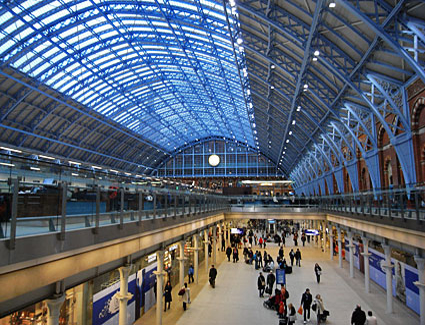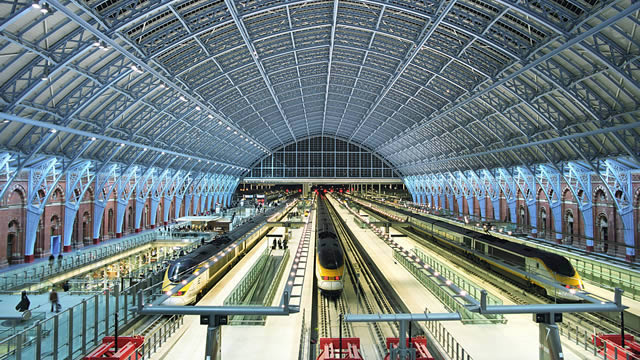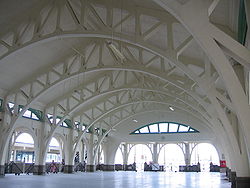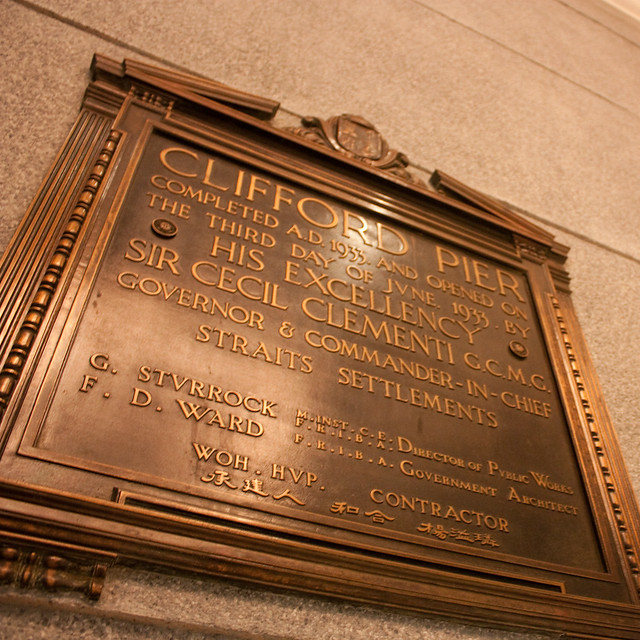Marina Bay & Singapore River
South, Singapore
May 2013
(This article is part of Merlion Wayfarer's Fullerton Heritage Guided Tour series.)
| The Call Of The Red Lanterns | A "Fight" Between Johnston And Clifford |
| The Watchman Of The Waters |
| The Call Of The Red Lanterns | A "Fight" Between Johnston And Clifford |
| The Watchman Of The Waters |
Clifford Pier, named after Governor Sir Hugh Charles Clifford, was opened in 1933. Designed by the Public Works Department (PWD) where Frank Dorrington Ward was the Chief Architect, this Art-Deco style landmark constructed by Woh Hup features a series of graceful concrete arches and elegant architectural details along its facade. Huge steel piles were hammered into the seabed to strength its foundation and maintain its structure and unique architecture.
Today, the majesty and grandeur of the old Clifford Pier has been preserved with artistic taste and adherence to its maritime origin. It was granted conservation status by the Urban Redevelopment Authority (URA) in 2007. The restoration was handled by DP Architects, winning it the URA Architectural Heritage Awards in 2011.
Two of its star architectural treasures kick off a list of many that have been earnestly brought back to life – the signature concrete arched trusses in rib band form and its magnificent multi-hued, stained glass fanlight.
Today, the majesty and grandeur of the old Clifford Pier has been preserved with artistic taste and adherence to its maritime origin. It was granted conservation status by the Urban Redevelopment Authority (URA) in 2007. The restoration was handled by DP Architects, winning it the URA Architectural Heritage Awards in 2011.
The Roof
Two of its star architectural treasures kick off a list of many that have been earnestly brought back to life – the signature concrete arched trusses in rib band form and its magnificent multi-hued, stained glass fanlight.
The rows upon rows of concrete arch trusses - With a central spine, these are arranged like bands of ribs.
This unique design supports the long roof running the length of the entire pier...
This unique design supports the long roof running the length of the entire pier...
This design is similar to London's St Pancras Railway Station...
(Sources - clockwise : Wikipedia, TravelStay, VisitLondon)
The Interior
As the design of the building is akin to those of industrial buildings of the Victorian era, where there is a wide expanse of space within. Like factories, warehouses and railway stations, there are no columns or partitions.
Clifford Pier in its earlier days with its open concept allowing the sea breeze to ventilate the building naturally...
(Source : Wikipedia)
Even today, the whole interior of the building is not compartmentalized by rooms or walls...
Facing The Road
The grand facade with its fan shape was painstaking preserved. Palm trees and low bushes were cleared to exhibit the entrance in its full grandeur...
Yesterday's entrance contrasted with today's...
(Sources : Flickr, Moon World Tourism, Open Buildings)
The Straits Settlement coat of arms still remains on the front facade...
(Source : Open Buildings & Times of Singapura)
The Straits Settlements consisted of the three individual settlements of Malacca, Penang and Singapore (with Christmas Island and the Cocos Keeling Islands). The island of Labuan, off the coast of Borneo, was included in the Straits Settlements from the early 1900s.
(Source : Wikipedia)
Little Hidden Details
Unique elements, such as the brackets supporting the roof with their original Shanghai plaster finish and the authentic antiquated artifacts, including the cast iron red lamps and commemorative plaques, have been faithfully salvaged.
To prepare the building for air-conditioning, glass panels were sensitively introduced behind the building facade, and service trays neatly suspended along the aisles so as not to camouflage the cherished textures of the past...
An intricate screen with a carved wood sculpture in front with the path leading to the water
is lined with lanterns lit with big candles...
is lined with lanterns lit with big candles...
The supports tethering boats to the pier were preserved in their originality...
In some parts of Clifford Pier, new walls were built to separate the lobby from the adjoining restaurants.
These walls were tastefully "hidden" with artistic features...
These walls were tastefully "hidden" with artistic features...
The plaque with details of the original architect and contractor...
(Source : Flickr)
The stone tiles decorating the edges of the roof and ceiling columns were maintained, albeit in stone now...
Most importantly, there were at least two examples of the famed cast iron red lamps throughout...
These were identical to the ones at the original Clifford Pier before its restoration...
(The walkway in the second photo has since been demolished to make way for an open area with artworks and a fountain.)










































